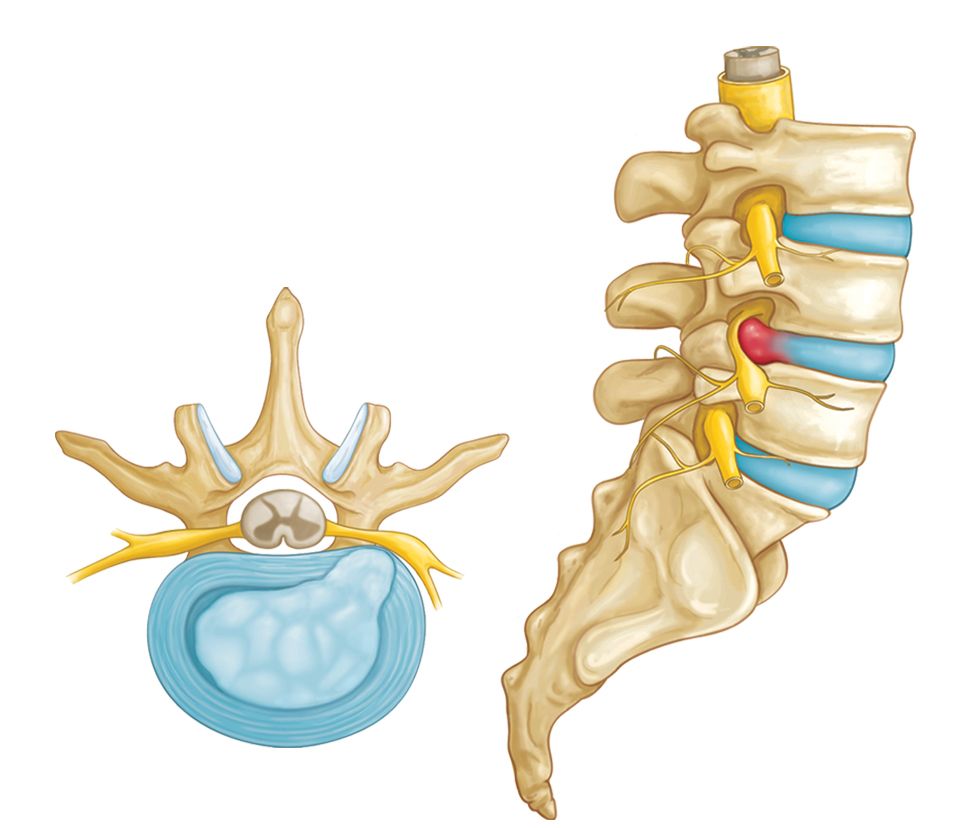Herniated Disk: Symptoms, Causes, Treatment
What are the symptoms of a herniated disk?
A herniated disk, also known as a slipped or ruptured disk, occurs when some of the soft jelly-like center of a spinal disk pushes out through a tear in the tougher exterior. The symptoms of a herniated disk can vary depending on the location and severity of the herniation. Common symptoms include:
- Pain: Herniated disks often cause pain in the area of the affected disk. The pain may radiate to other parts of the body, such as the buttocks, thighs, or calves, depending on the location of the herniation.
- Numbness or tingling: You may experience numbness or tingling in the area of the body served by the affected nerves. For example, a herniated disk in the lower back can cause numbness or tingling in the legs or feet.
- Weakness: Muscle weakness can occur in the affected area. For instance, a herniated disk in the neck can cause weakness in the arms or hands.
- Changes in reflexes: Herniated disks can affect the reflexes, leading to changes in how you react to stimuli. This is more commonly seen in severe cases.
- Sciatica: If the herniated disk compresses the sciatic nerve, it can cause pain, numbness, or tingling that radiates from the lower back down the leg (sciatica).
It’s important to note that not all herniated disks cause symptoms, and the severity of symptoms can vary widely among individuals. If you experience persistent back pain or other symptoms that could be related to a herniated disk, it’s important to consult with a healthcare provider for an accurate diagnosis and appropriate treatment.
What are the causes of a herniated disk?
A herniated disk is typically caused by wear and tear on the spine, but it can also be the result of an injury. The spinal disks are made up of a tough outer layer (annulus fibrosus) and a gel-like inner substance (nucleus pulposus). When a disk herniates, the inner substance pushes through a tear or weak spot in the outer layer. Some common causes of a herniated disk include:
- Age-related wear and tear: As we age, the spinal disks lose water content, making them less flexible and more prone to tearing or rupturing with minor strain or twisting movements.
- Repetitive strain: Certain occupations or activities that involve repetitive lifting, twisting, or bending motions can increase the risk of a herniated disk.
- Traumatic injury: A sudden, traumatic injury, such as a fall or a blow to the back, can cause a disk to herniate.
- Obesity: Excess body weight can put added pressure on the spine and increase the risk of disk herniation.
- Genetics: Some people may have a genetic predisposition to developing herniated disks, as certain inherited traits can affect the structure and integrity of the spinal disks.
- Poor posture: Poor posture, especially when sitting or standing for long periods, can contribute to disk herniation over time.
- Smoking: Smoking can impair the blood supply to the spinal disks, increasing the risk of disk degeneration and herniation.
It’s important to note that not everyone with these risk factors will develop a herniated disk, and in many cases, the exact cause of a herniated disk is unknown. Treatment for a herniated disk usually focuses on relieving symptoms and improving mobility, and most people with a herniated disk do not require surgery.
What is the treatment for a herniated disk?
The treatment for a herniated disk depends on the severity of symptoms and the impact on daily life. In many cases, a herniated disk will improve on its own with conservative treatments. Common treatment options include:
- Pain management: Over-the-counter pain medications such as acetaminophen or ibuprofen can help relieve pain and inflammation associated with a herniated disk.
- Physical therapy: Physical therapy can help improve strength, flexibility, and range of motion. Specific exercises can also help relieve pressure on the nerves affected by the herniated disk.
- Steroid injections: Corticosteroid injections can help reduce inflammation and relieve pain. These injections are typically given directly into the area around the affected nerve.
- Heat and cold therapy: Applying heat or cold to the affected area can help reduce pain and inflammation. Heat therapy is often used to relax muscles, while cold therapy can help numb the area and reduce swelling.
- Rest: In some cases, resting and avoiding activities that worsen symptoms can help the herniated disk heal. However, prolonged bed rest is generally not recommended, as it can lead to muscle stiffness and weakness.
- Surgery: In severe cases where conservative treatments have not been effective and symptoms are severe or worsening, surgery may be recommended. The most common surgical procedure for a herniated disk is a discectomy, where the portion of the disk causing pressure on the nerve is removed.
It’s important to consult with a healthcare provider for an accurate diagnosis and appropriate treatment plan if you suspect you have a herniated disk. They can help determine the best course of action based on your symptoms, medical history, and lifestyle.




